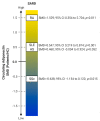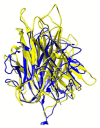Adiponectin Deregulation in Systemic Autoimmune Rheumatic Diseases
- PMID: 33920997
- PMCID: PMC8071452
- DOI: 10.3390/ijms22084095
Adiponectin Deregulation in Systemic Autoimmune Rheumatic Diseases
Abstract
Deregulation of adiponectin is found in systemic autoimmune rheumatic diseases (SARDs). Its expression is downregulated by various inflammatory mediators, but paradoxically, elevated serum levels are present in SARDs with high inflammatory components, such as rheumatoid arthritis and systemic lupus erythematosus. Circulating adiponectin is positively associated with radiographic progression in rheumatoid arthritis as well as with cardiovascular risks and lupus nephritis in systemic lupus erythematosus. However, in SARDs with less prominent inflammation, such as systemic sclerosis, adiponectin levels are low and correlate negatively with disease activity. Regulators of adiponectin gene expression (PPAR-γ, Id3, ATF3, and SIRT1) and inflammatory cytokines (interleukin 6 and tumor necrosis factor α) are differentially expressed in SARDs and could therefore influence total adiponectin levels. In addition, anti-inflammatory therapy could also have an impact, as tocilizumab treatment is associated with increased serum adiponectin. However, anti-tumor necrosis factor α treatment does not seem to affect its levels. Our review provides an overview of studies on adiponectin levels in the bloodstream and other biological samples from SARD patients and presents some possible explanations why adiponectin is deregulated in the context of therapy and gene regulation.
Keywords: PPAR-γ; adiponectin; gene regulation; interleukin 6; systemic autoimmune rheumatic diseases; therapy; tumor necrosis factor α.
Conflict of interest statement
The authors declare no conflict of interest.
Figures







Similar articles
-
Adiponectin in autoimmune diseases.Curr Med Chem. 2012;19(32):5474-80. doi: 10.2174/092986712803833119. Curr Med Chem. 2012. PMID: 22876925 Review.
-
Prevalence of systemic autoimmune rheumatic diseases and clinical significance of ANA profile: data from a tertiary hospital in Shanghai, China.APMIS. 2016 Sep;124(9):805-11. doi: 10.1111/apm.12564. Epub 2016 Jun 22. APMIS. 2016. PMID: 27328803
-
Serum uric acid increases in patients with systemic autoimmune rheumatic diseases after 3 months of treatment with TNF inhibitors.Rheumatol Int. 2019 Oct;39(10):1749-1757. doi: 10.1007/s00296-019-04394-6. Epub 2019 Jul 31. Rheumatol Int. 2019. PMID: 31363829
-
Comparisons of neutrophil-, monocyte-, eosinophil-, and basophil- lymphocyte ratios among various systemic autoimmune rheumatic diseases.APMIS. 2017 Oct;125(10):863-871. doi: 10.1111/apm.12722. Epub 2017 Aug 2. APMIS. 2017. PMID: 28766758
-
Bronchiolar disorders in systemic autoimmune rheumatic diseases.Eur Respir Rev. 2025 Apr 16;34(176):240248. doi: 10.1183/16000617.0248-2024. Print 2025 Apr. Eur Respir Rev. 2025. PMID: 40240060 Free PMC article. Review.
Cited by
-
Endothelin receptor antagonism improves glucose tolerance and adipose tissue inflammation in an experimental model of systemic lupus erythematosus.Am J Physiol Endocrinol Metab. 2023 Jan 1;324(1):E73-E84. doi: 10.1152/ajpendo.00274.2022. Epub 2022 Dec 7. Am J Physiol Endocrinol Metab. 2023. PMID: 36476039 Free PMC article.
-
Effects of One-Year Tofacitinib Therapy on Lipids and Adipokines in Association with Vascular Pathophysiology in Rheumatoid Arthritis.Biomolecules. 2022 Oct 14;12(10):1483. doi: 10.3390/biom12101483. Biomolecules. 2022. PMID: 36291691 Free PMC article.
-
Sirt1 protects lupus nephritis by inhibiting the NLRP3 signaling pathway in human glomerular mesangial cells.Open Life Sci. 2025 Apr 25;20(1):20221038. doi: 10.1515/biol-2022-1038. eCollection 2025. Open Life Sci. 2025. PMID: 40291778 Free PMC article.
-
An Explanation for the Adiponectin Paradox.Pharmaceuticals (Basel). 2021 Dec 4;14(12):1266. doi: 10.3390/ph14121266. Pharmaceuticals (Basel). 2021. PMID: 34959666 Free PMC article. Review.
-
Adipokines and Adipose Tissue: The Role and Use of Sodium-Glucose Co-Transporter-2 (SGLT-2) Inhibitors in Patients with Diabetes or Heart Failure.Biomedicines. 2025 Apr 30;13(5):1098. doi: 10.3390/biomedicines13051098. Biomedicines. 2025. PMID: 40426925 Free PMC article. Review.
References
Publication types
MeSH terms
Substances
Grants and funding
LinkOut - more resources
Full Text Sources
Other Literature Sources
Medical
Miscellaneous

